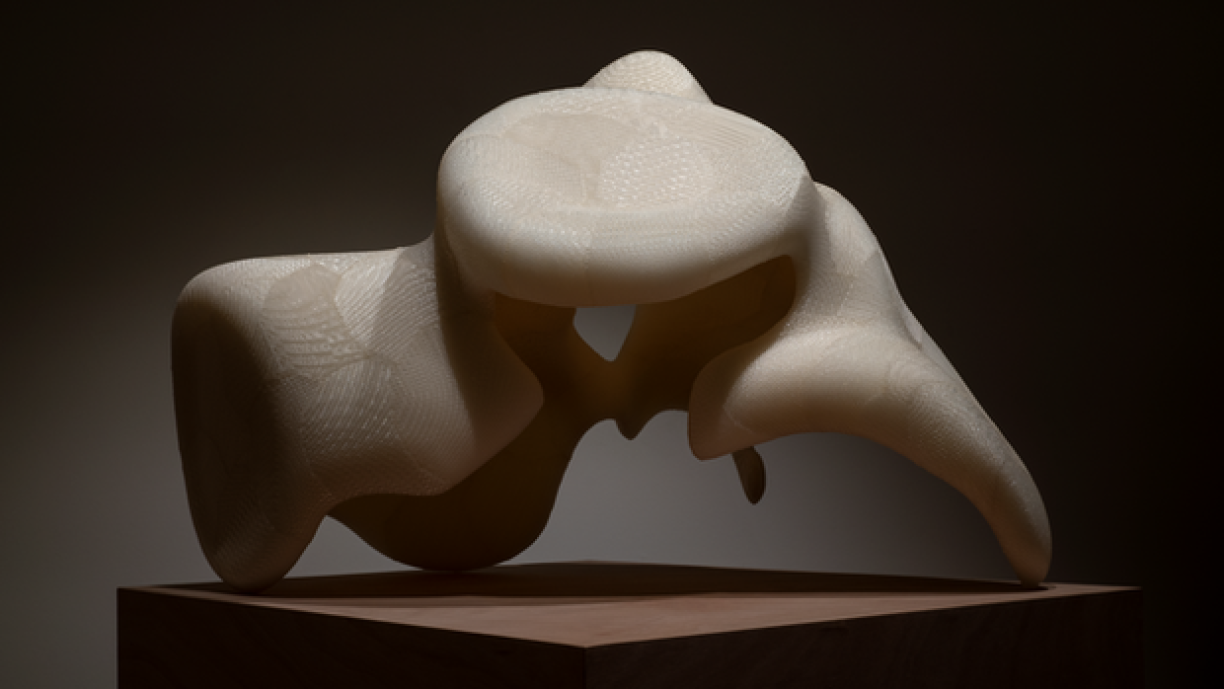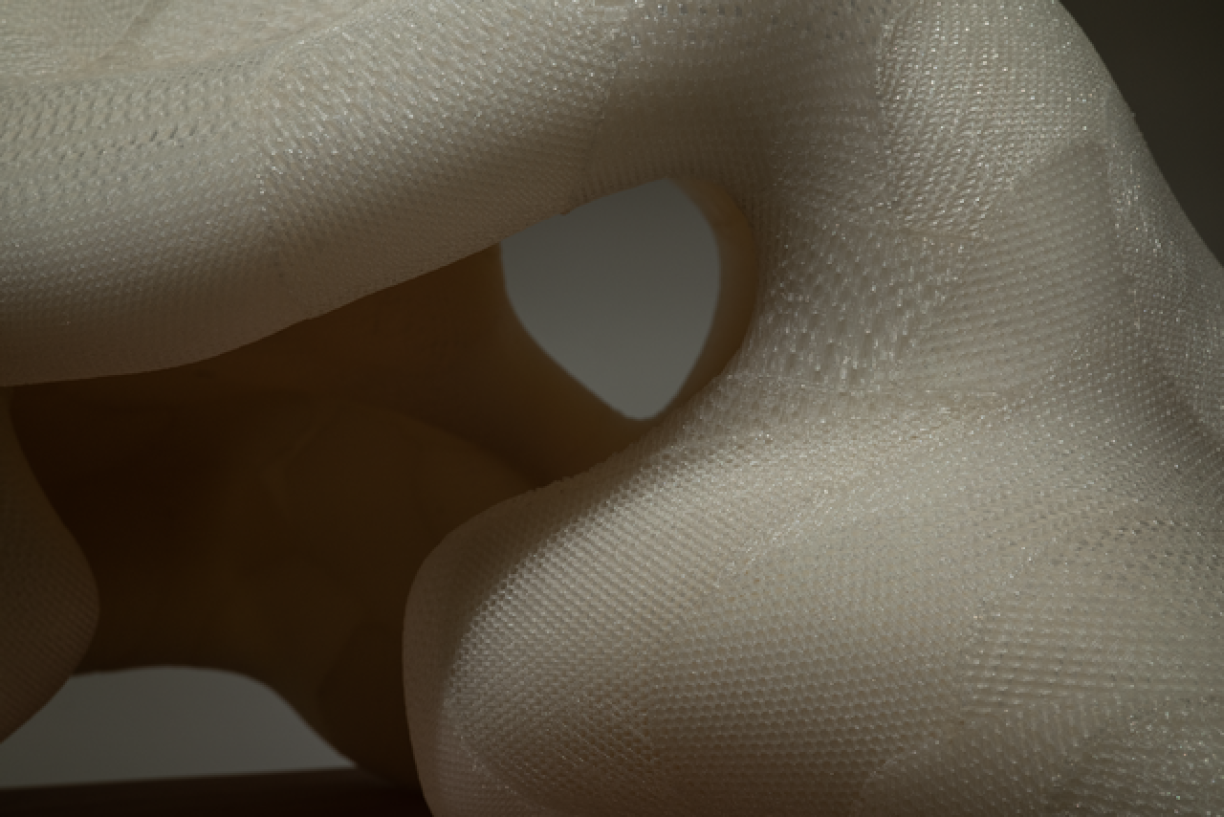
De Präis gouf vun engem gréissere Jury verginn, deen sech unanime fir de Pit Molling entscheet huet. De Lëtzebuerger Kënschtler gouf 1984 zu Lëtzebuerg gebuer an huet säin Diplom bei der FADBK zu Essen gemaach.
Déi nächsten Editioun ass fir 2025 virgesinn.

Communiqué de presse
Prix de la sculpture Schlassgoart décerné à Pit Molling
Esch-sur-Alzette, le 1er juillet 2022
Le jury du Prix de la sculpture Schlassgoart s’est réuni le 16 juin 2022.
A l’issue de ses débats, le jury a décerné à l’unanimité de ses membres le Prix
de la sculpture Schlassgoart à l’artiste Pit Molling, Né en 1984 à Luxembourg et
diplômé de la FADBK d’Essen, Pit Molling a présenté au jury une oeuvre réalisée par
le biais de l’impression 3D FDM (Fused deposition modeling), montrant ses
tentatives à capter la structure esthétique universelle du monde sous forme digitale,
afin de la reproduire en réel. S’intéressant à l’évidence de l’art numérique, Pit
Molling questionne ainsi la véracité du monde virtuel à travers l’art, cherchant à
résister aux tendances actuelles d’un art impersonnel, léger et amusant, en refusant de
réduire son travail à un simple produit culturel consommable.
Mr Godfrey Worsdale président du jury a résumé comme suit l’appréciation du
jury sur le lauréat et les autres candidats retenus pour l’octroi du Grand Prix de la
Sculpture 2022 :
The practice of sculpture is a complex and shifting preoccupation. Unlike
painting, which seems to wain repeatedly before a predictable but notable
resurgence, sculpture proceeds along a number of strands, sometimes parallel and at
other times converging and overlapping. To be asked to consider and compare the
practice of a group of sculptors therefore can be an arduous challenge, and this was
the task of the Jury for the selection of this year’s Prix de la Sculpture, Schlassgoart.
Each finalist had presented work for consideration that demonstrated an
intimacy and sensitivity to their chosen material and process of execution, but in
each and every case, a clear and unique identity was palpable.
For both Gerard Claude and Jhemp Bastin, the possibilities of wood, a
sculptor’s material as old as the practice, is seen to be far from exhausted. Their
respective submissions demonstrate in very different ways, that great potential still
exists to engage with a material that is unpredictable and characterful, bringing its
own identity to the work. An entirely different approach is adopted by Armand
Strainchamps, whose proposal brings sculpture into dialogue with 2-dimensional
imagery and on into social exchange - his figures, at once images and objects,
interrupt and relate to our human curiosity with identity and personality, being
amongst us and reflecting our interactions.
Serge Ecker has proposed an idea that is also social, but in this case it is
associated with the language of architectural surface and the environment in which
we exist.
Manolis Manarakis made a powerful proposal, which spoke directly to the
challenge of human interaction and hierarchy; as the small looks up to the powerful
and strong, we reflect on the possibility of resistance and of authority. At the same
time we recognise the classical modernist device of two forms interacting and in pure
sculptural terms, generating tension.
Ann Vinck, forms primal characters from terracotta, speaking directly to the
human condition, whilst Ellen van der Woude takes us into infinitesimal detail
exquisitely executed in porcelain as she recreates the implausible perfections of the
natural world - creating something that seems to have grown without human
intervention.
Each of these sculptors is able to show us all something about the world we
inhabit and the way in which we understand our selves. Again, somewhat differently
to painting, sculpture - with its ever expanding lexicon of materials and techniques -
is open to a vast range of possibilities. To retain its relevance, sculpture will always
find ways to include new technologies into its vocabulary. However, the adoption of a
new technique doesn’t necessarily facilitate the realisation of innovative work.
Our winner of the 2022 Prix de la Sculpture, has engaged with one of the most
significant technological interventions in sculpture for many years - digital printing.
This technology offers endless possibilities for the lives we live and that we will live
in the future, but for the artist, here-in is a risk. Such is the revolutionary nature of
this process, that its very deployment in an artistic purpose is all too often seen as a
sufficient endeavour for the results to be of interest and value.
In fact, the use of this technology is, in all the important ways, very similar to
the tradition of making sculpture in wood, as Claude and Bastin have both
demonstrated here, which should be subject to endless care, refinement and
experimentation for great results to be achieved. This brings us to our new Laureate;
Pit Molling, whose winning submission, once conceived was produced with this new
technology. For this year’s jury, there were two fundamental reasons for his success.
Firstly, the artist has not given over any authorship to the medium, which all
too often can produce work lacking in refinement and character, he has instead
created a seductive surface making endlessly rewarding references to finely woven
fabrics, which might remind us of our own context; of the clothing we wear or the
fabrics within our domestic environment. This meticulous effect is then orchestrated
like the surface of a minimalist painter’s canvas, whose obsession is focussed on the
way in which his work might reflect light. Perhaps informed by the artists time as a
painting student in Essen.
The second crucial characteristic is to be found in the way Molling’s work
references the forms of classical modernism; a terrain where the natural form and
the machine-made product had to learn to interact and contradict one another. Here
Molling powerfully projects that comment by placing his amorphous form on a
meticulous light-coloured wooden plinth. Though abstract in nature and quiet in its
initial presentation, Molling’s work is remarkably human and speaks of our social
situation, but it does so with calm and highly focussed allure.
Le jury du Prix de la sculpture Schlassgoart était composé de :
Godfrey Worsdale Directeur de la Fondation Henry Moore, Président du Jury
Pierre-Marc Knaff, Échevin à la culture de la Ville d’Esch-sur-Alzette
Erna Hennicot-Schoepges
Marc Hostert, Président du CAL
Michel Wurth, Président de la Galerie Schlassgoart
Nathalie Becker, directrice de la Galerie, a rempli les fonctions de secrétaire du jury
Le jury a tenu à remercier vivement tous les candidats pour leur contribution à
la réussite de l’édition 2022.
La création du Prix de la sculpture Schlassgoart a été annoncée en septembre
2018. Il est le fruit d’une collaboration entre la Ville d’Esch-sur-Alzette, la Galerie
Schlassgoart et le Cercle Artistique de Luxembourg pour promouvoir l’art
contemporain au Luxembourg.
La prochaine édition du Prix de la sculpture Schlassgoart est prévue pour 2025.